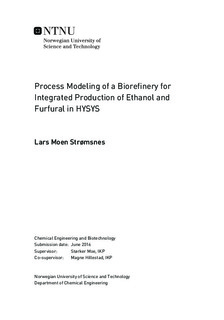Process Modeling of a Biorefinery for Integrated Production of Ethanol and Furfural in HYSYS
Master thesis
Permanent lenke
http://hdl.handle.net/11250/2411071Utgivelsesdato
2016Metadata
Vis full innførselSamlinger
Sammendrag
Existing bioethanol production relies heavily on the use of corn and sugarcane as feedstocks. A prerequisite for increased consumption of bioethanol is the transition from the current use of corn and sugarcane to lignocellulosic biomass. This includes the use of wood, straws and agricultural residue such as sugarcane bagasse and corn stover, which do not compete directly with food production. Cellulosic ethanol also offers increased reduction in greenhouse gas emissions over both current bioethanol and petroleum based fuels.
A biorefinery utilizing corn stover as feedstock has been designed and implemented in HYSYS. The model is based on the process for biochemical conversion of lignocellulosic biomass to ethanol designed by the U.S. National Renewable Energy Laboratory (NREL). The Marcotullio process for the production of furfural from aqueous xylose is integrated by selectively fractionating the feedstock into hemicellulose and cellulose. The model also includes a steam boiler cycle for co-generation of heat and electricity from residual solid material, and the biorefinery is found to be energy self-sufficient.
The performance of the biorefinery is comparable to the NREL and Marcotullio processes. The combined conversion of useful carbohydrates into ethanol and furfural is found to be 81.1%, which corresponds to 47% of the total energy content in the corn stover feedstock. The heating demand is slightly increased compared to the NREL process, and generation of electricity is reduced.
